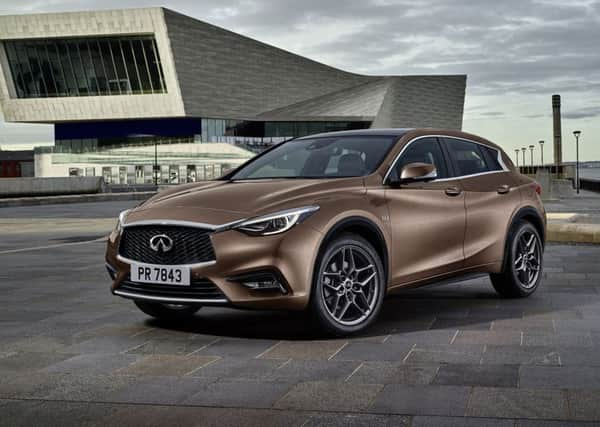Nissan dares to be different with Infiniti Q30


Infiniti is the plush part of Nissan, akin to Lexus with Toyota, Audi with Volkswagen. The Q30 is the first Infiniti to be built at Nissan’s super-effective Sunderland factory. So, you might reasonably think that beneath the ebullient, bespoke exterior there’s a Nissan Qashqai or maybe a Renault Kadjar.
Not so fast, and not so simple and not at all. Q30 is Infiniti’s version of the Mercedes-Benz GLA. Yep, the chassis, gearboxes and all but one engine are supplied by the Germans. It’s part of the Daimler Renault Nissan Alliance that has already created the Renault Twingo and Smart ForFour.
Advertisement
Hide AdInfiniti says it has built a better car than its German sire, with enhancements to steering and suspension refinement and general refinement. After this first experience I am not in the mood to argue. The Infinitis we drove were early models, so can be allowed a few rattles and wind noise from the mirrors – perhaps audible because the rest of this five-door family car is so quiet, the best in class in fact.
Deliveries will begin in the New Year. It is a £250 million investment bringing some 300 jobs to a region suffering from the sudden closure of the Redcar steel plant. The Q30 is up against not only the GLA, but the Audi Q3, BMW Active 2 Series and Volvo V40. It’s a stern test of smart opposition for a brand which largely goes unnoticed, a tiddler swimming among Teutonic salmon – and Swedish char. Like its rivals, Q30 is front-wheel-drive, but with the option of four-wheel-drive on the 168bhp 2.2 diesel and fitted as standard on the 208bhp 2-litre petrol Sport model. The 4WD is permanently engaged and can switch 50 per cent of power to the rear wheels. It comes only with a seven speed twin clutch automatic gear change.
Prices open at an attractive £20,550 for the 121bhp 1.6 petrol SE. The biggest seller is expected to be the 107bhp 1.5 diesel – the only Nissan engine in the Q30. Prices for this begin at £21,500 in SE trim. The cheapest 2.2 diesel is the front-drive automatic SE at £24,700. The Q30 rides higher than most hatchbacks, designed to meet the rigours of unruly urban roads. The suspension has been developed to counteract excessive roll and still give a comfy ride, which it does. It is calibrated to suit the heavier engines, while the Sport models (offered with both the diesel engines and the 2-litre petrol), ride lower and have stiffer suspension.
It comes to market on the crest of rising Infiniti world sales – in the first nine months reaching 154,600. As a comparison, Jaguar sold just 81,570 cars in the whole of last year. Infiniti sales in the UK in the first 11 months were just 1,129 – but that’s a 69 per cent increase on last year. It wants to expand from 10 to 25 dealers.
Most of our drive was in the 1.5 diesel. It is no race horse, with a 0-62mph time with manual gears around 12 seconds. The figures with automatic gears are similar. The CO2 rating (on 17-inch wheels) is 108g and the combined average is 60.3mpg. Our test car was on 18-inch wheels, which will be standard on all UK models. The trip computer on a flattish hour loop suggested 51 miles a gallon. We had no complaints about its performance. Diesel engines always give more than the bald 0-62mph time and this turbo diesel has a hefty 192 lb ft of torque between 1,750 and 2,500rpm. The predictable throttle response gave confidence when overtaking. Generally, it all felt good.
The plump furniture and stitched edges, with slivers of banded veneer in the doors, give a clubby, Rover 75 comfort. Outside, though, there’s an effrontery of curves loved by the Asian bloc, enhanced by sunlight in the new copper metallic paint. Along the door sills runs a black plastic blade. To keep muck off the door edges? No, apparently it is a styling feature to enhance the shape. The car looks odd without it, said an Infiniti engineer.
Advertisement
Hide AdAppearances are a matter of opinion. The Q30 is hard to miss. At this stage, I like it but the reality is that most customers are going to get something German in this category. The Q30 will appeal to someone who likes its pricing strategy and its adventurous styling. He or she will either not bother or be unaffected by resale prospects or be using a PCP rental plan. The rarity implies that there should be someone wanting your “old” Q30.
Verdict: Stand out from the masses with this attractive all-rounder.